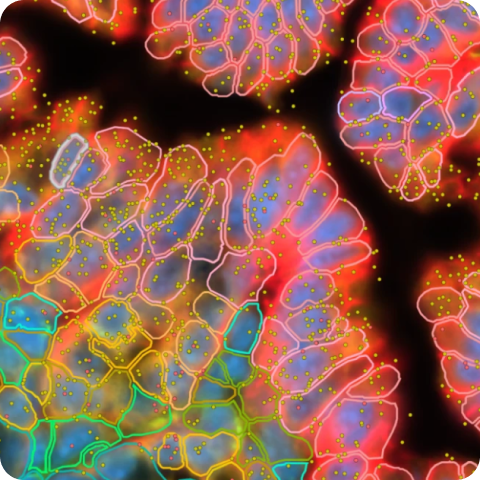Human Bone and Bone Marrow Data with Custom Add-on Panel
In Situ Gene Expression dataset analyzed using Xenium Onboard Analysis 1.9.0


Learn about Xenium analysis
Overview
Bone marrow plays a crucial role in diagnosing various conditions. By analyzing gene expression within bone marrow, researchers can gain insights into hematological disorders, immune responses, and other diseases. Bones present a unique challenge due to their hardness and inaccessibility. To address this, we have focused on optimized sample handling techniques.
This page demonstrates Xenium In Situ Gene Expression data for adult human bone and bone marrow sections using the Xenium Human Multi-Tissue and Cancer Panel with custom add-on.
How to view data
Interactively explore data with Xenium Explorer by downloading the Xenium Output Bundle (or Xenium Explorer subset) file. The subset bundle contains the experiment.xenium, morphology_mip.ome.tif, analysis_summary.html, cells.zarr.zip, cell_feature_matrix.zarr.zip, transcripts.zarr.zip, and analysis.zarr.zip files. See the Getting Started with Xenium Explorer page for more details. Follow these instructions to view the post-Xenium H&E image or image alignment file in Xenium Explorer.
Biomaterials and sample handling
FFPE-preserved tissues were purchased from Discovery Life Sciences (Acute Lymphoid Leukemia bone marrow), Precision Biospecimens (non-diseased bone marrow), and Avaden Biosciences (non-diseased femur bone). The femur sample was delivered in fixative and the decalcification, processing, and embedding were done by 10x Genomics.
Prior to processing and embedding (tissue preparation):
- Human Bone: Decalcified for approximately 3 weeks with 0.5M EDTA in 50 mL conical stored at 4°C. EDTA was replenished tri-weekly to minimize reagent degradation.
- Human Bone Marrow: No decalcification necessary. Proceeded directly with tissue processing and paraffin embedding.
Additional guidance for bone sample preparation is available in this Knowledge Base article.
Tissue preparation
Tissues were prepared following the Demonstrated Protocols Xenium In Situ for FFPE - Tissue Preparation Guide (CG000578) and Xenium In Situ for FFPE Tissues – Deparaffinization & Decrosslinking (CG000580). Probe hybridization, washing, ligation, and amplification were performed following the Xenium In Situ Gene Expression User Guide (CG000582).
Post-instrument processing followed the Demonstrated Protocol Xenium In Situ Gene Expression - Post-Xenium Analyzer H&E Staining (CG000613).
Gene panels
The Xenium Human Multi-Tissue and Cancer Panel (377 genes) was pre-designed by 10x Genomics. The panel design was informed using single cell RNA sequencing data curated and reprocessed for standardization by the Human Protein Atlas. Genes were chosen to accurately type cells, and identify select immune, proliferation, and tumor markers, in human breast, lung, skin, liver, colon, kidney, lung cancer, and heart.
To enhance detection of bone cell types, we added a 100-gene custom add-on panel to supplement the identification of blood progenitors, endothelial cells, macrophages, stromal cells (smooth muscle and fibroblasts), T cells, and B cells detected in bone marrow. The add-on gene list for these datasets is available as a supplemental file. It includes panel gene name, transcript ID, and cell type annotation in CSV format.
Xenium Analyzer
The instrument run was performed following the Xenium Analyzer User Guide (CG000584). The on-instrument analysis was run with Xenium Onboard Analysis version 1.9.0.
| Metric | Acute Lymphoid Leukemia bone marrow | Non-diseased bone marrow | Non-diseased femur |
|---|---|---|---|
| Median transcripts per cell | 27 | 7 | 13 |
| Cells detected | 225,906 | 84,518 | 33,801 |
| Decoded transcripts per 100 µm² | 52.5 | 8.4 | 7.3 |
| Total high quality decoded transcripts | 6,933,297 | 880,224 | 1,069,690 |
| Region area (µm²) | 26,288,545 | 23,683,544 | 73,260,729 |
This dataset is licensed under the Creative Commons Attribution 4.0 International (CC BY 4.0) license. 10x citation guidelines available here.